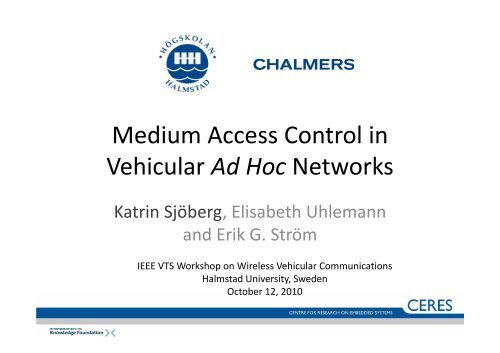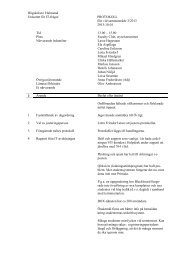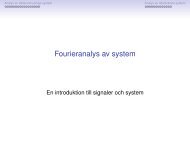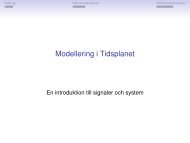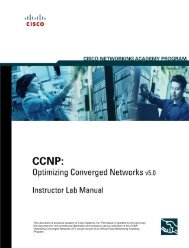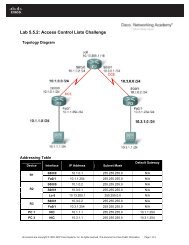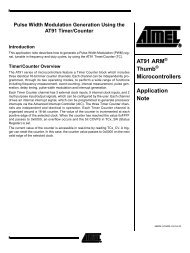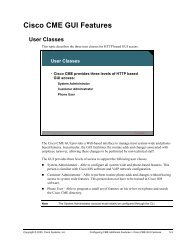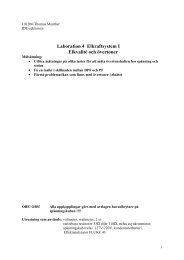Medium Access Control in Vehicular Ad Hoc Networks
Medium Access Control in Vehicular Ad Hoc Networks
Medium Access Control in Vehicular Ad Hoc Networks
Create successful ePaper yourself
Turn your PDF publications into a flip-book with our unique Google optimized e-Paper software.
<strong>Medium</strong> <strong>Access</strong> <strong>Control</strong> <strong>in</strong><br />
<strong>Vehicular</strong> <strong>Ad</strong> <strong>Hoc</strong> <strong>Networks</strong><br />
Katr<strong>in</strong> Sjöberg, Elisabeth Uhlemann<br />
and Erik G. Ström<br />
IEEE VTS Workshop on Wireless <strong>Vehicular</strong> Communications<br />
Halmstad University, Sweden<br />
October 12, 2010
MAC<br />
Reliability<br />
VANET<br />
STDMA<br />
Scalability<br />
STDMA<br />
IEEE 802.11p<br />
VANET<br />
TCP/IP model dl<br />
Introduction<br />
HTTP, FTP<br />
DHCP, DNS<br />
Telnet etc.<br />
TCP/UDP<br />
IP<br />
OSI model dl<br />
Application<br />
Presentation<br />
Session<br />
Transport<br />
MAC<br />
Predictability<br />
IEEE 802.11p<br />
MAC<br />
VANET<br />
Scalability<br />
STDMA<br />
IEEE 802.11p<br />
VANET<br />
STDMA Delay<br />
Scalability<br />
Network LLC<br />
IEEE 802.11p<br />
WiFi/Ethernet<br />
Data l<strong>in</strong>k<br />
MAC<br />
Predictability<br />
WiFi/Ethernet Physical<br />
IEEE 802.11p<br />
Scalability<br />
Scalability<br />
IEEE 802.11p STDMA<br />
Delay<br />
IEEE 802.11p<br />
IEEE 802.11p<br />
STDMA<br />
MAC<br />
VANET
What is a VANET?<br />
• <strong>Vehicular</strong> ad hoc networks<br />
• Dezentralized network topology<br />
– No access po<strong>in</strong>t or base station<br />
– Peer‐to‐peer communication<br />
i<br />
• Self‐organization<br />
• Can conta<strong>in</strong> roadside units (RSU)<br />
Direct vehicle‐to‐vehicle (V2V)<br />
<strong>Ad</strong> hoc no central entity.
Characteristics of VANETs<br />
• Share a common communication i channel<br />
• Broadcast<br />
– Traditional Automatic Repeat reQuest (ARQ) are<br />
not available<br />
• The multipath environment where the<br />
radiowaves propagate<br />
– 5.9 GHz has been chosen for VANETs<br />
• The number of participat<strong>in</strong>g i nodes <strong>in</strong> a VANET<br />
cannot be restricted
Why Traffic Safety Applications?<br />
…. decrease the number of traffic accidents by <strong>in</strong>troduc<strong>in</strong>g traffic<br />
safety applications, but also to reduce congestion, travel‐time, and<br />
pollution through traffic efficiency applications…<br />
• Lane change warn<strong>in</strong>g<br />
• Overtak<strong>in</strong>g vehicle<br />
• Merge assistance it<br />
• Use different communication technologies<br />
depend<strong>in</strong>g on application<br />
– IEEE 802.11p, 3G, Mobile WiMAX
Real‐Time Communication<br />
• Trafficsafety f applications i have concurrent<br />
requirements on delay and reliability<br />
• Packets have a deadl<strong>in</strong>e to meet<br />
• Time‐triggered position messages<br />
Broadcast<br />
– 2‐10 Hz, 300‐800 byte<br />
– Cooperative awareness messages (CAM)<br />
– Facility: Local dynamic map<br />
• Event‐driven hazard warn<strong>in</strong>gs<br />
Broadcast<br />
– Packet size and periodicity depend on traffic safety<br />
application<br />
Here I am!
<strong>Medium</strong> <strong>Access</strong> <strong>Control</strong> <strong>in</strong> VANET<br />
• Responsible for schedul<strong>in</strong>g channel access to<br />
m<strong>in</strong>imize <strong>in</strong>terference to <strong>in</strong>crease reliability<br />
• How to guarantee these low delay<br />
applications that the packet arrives <strong>in</strong> time?<br />
• The MAC method must be decentralized,<br />
scalable and predictable<br />
• Only standard support<strong>in</strong>g direct vehicle‐tovehicle<br />
communication is 802.11p<br />
– 5.9 GHz
WAVE<br />
WAVE = Wireless <strong>Access</strong> <strong>in</strong> <strong>Vehicular</strong> Environment<br />
Application HTTP<br />
1609.1<br />
etc<br />
Transport<br />
TCP/<br />
UDP<br />
WSMP<br />
Network IPv6<br />
Logical l<strong>in</strong>k<br />
<strong>Medium</strong> access<br />
Physical<br />
LLC 802.2<br />
802.11p 1609.4<br />
802.11p<br />
1609.3<br />
1609.2<br />
Security<br />
1609.0 WAVE<br />
Architecture<br />
1609.5 WAVE<br />
Communications<br />
i<br />
Manager<br />
started dur<strong>in</strong>g<br />
spr<strong>in</strong>g 2008.<br />
WSMP –WAVE Short Message protocol<br />
WAVE = IEEE 802.11p, 1609.0, 1609.1, 1609.2, 1609.3, 1609.4 and 1609.5
IEEE 802.11p<br />
• RtifidJ Ratified July 2010<br />
• PHY and MAC amendment<br />
– No support for access po<strong>in</strong>ts<br />
– Peer‐to‐peer mode (ad hoc)<br />
• IEEE 802.11a OFDM physical layer<br />
– 3, 4.5, 6, 9, 12, 18, 24 and 27 Mbps<br />
– 5.850‐5.925 GHz Intelligent Transportation Systems Radio<br />
Service (ITS‐RS)<br />
– 10 MHz channels<br />
– 1 control channel and 6 service channels (WAVE 1609.4)<br />
• European standard d( (ETSI) – ITS G5<br />
• Worldwide standard (ISO) –CALM M5
IEEE 802.11p – MAC<br />
• Carrier sense multiple li l access with ihcollision i avoidance<br />
(CSMA/CA)<br />
• IEEE 802.11e QoS<br />
– Provides 4 different priority levels<br />
• Starts listen<strong>in</strong>g to the channel dur<strong>in</strong>g one AIFS<br />
– Arbitration InterFrame Space (58 µs, highest priority <strong>in</strong> 802.11e)<br />
• Channel becomes busy dur<strong>in</strong>g listen<strong>in</strong>g period<br />
– Perform backoff by select<strong>in</strong>g a random number<br />
– Decrement backoff only when channel is free<br />
• A node sends directly if the channel was free dur<strong>in</strong>g one<br />
AIFS
CSMA/CA drawbacks<br />
• Unpredictable channel access dl delay<br />
– Periodic messages need to be sent with<strong>in</strong> its time period<br />
– The random backoff may cause a delay dl longer than the<br />
time period<br />
– Causes packet drops at send<strong>in</strong>g node<br />
• Collisions<br />
– The random backoff time chosen are discrete and thus<br />
nodes may choose the same<br />
• For example <strong>in</strong> 802.11e highest priority –{0 µs, 13 µs, 26 µs, 39 µs}<br />
– Two concurrently transmitt<strong>in</strong>g nodes may be located very<br />
close together<br />
CSMA is not predictable nor scalable.
STDMA – a potential remedy?<br />
• Slf Self‐organiz<strong>in</strong>g ii time division i i multiple l access (STDMA)<br />
• Already <strong>in</strong> commercial use<br />
– Automatic Identification System (AIS)<br />
– VDL mode 4<br />
• Specially designed for position messages, e.g., eg CAM<br />
• Predictable channel access delay regardless of the<br />
number of compet<strong>in</strong>g nodes<br />
• In overloaded situation “collisions” are scheduled to<br />
m<strong>in</strong>imize <strong>in</strong>terference<br />
• Needs synchronization between nodes<br />
• Fixed packet length<br />
STDMA is predictable and scalable.
STDMA<br />
Node 1<br />
.<br />
.<br />
.<br />
.<br />
.<br />
Node n<br />
…..<br />
…..<br />
…..<br />
…..<br />
NTS<br />
SI<br />
NSS<br />
NI<br />
SI<br />
NI<br />
SI<br />
NS<br />
NTS<br />
NI<br />
…..<br />
NI NI NI<br />
SI<br />
NS NTS NSS NTS NS<br />
NTS<br />
SI<br />
…..<br />
…..<br />
…..<br />
Every node is allowed to<br />
choose a transmission<br />
slot from 20% of all<br />
available slots.<br />
A certa<strong>in</strong> slot is<br />
used for 3‐8<br />
consecutive frames.<br />
Fixed number of slots <strong>in</strong> the frame. All nodes have a unique frame start!<br />
STDMA needs position messages for schedul<strong>in</strong>g transmissions <strong>in</strong> space when all available<br />
STDMA needs position messages for schedul<strong>in</strong>g transmissions <strong>in</strong> space when all available<br />
slots are occupied, i.e., the 20% of all available slots that is accessible to one particular node.
Simulator <strong>in</strong> Matlab<br />
Data traffic model –time‐driven position messages, i.e., CAMs<br />
Vehicle traffic model – Poisson distributed, approx. 1 vehicle/100 meter<br />
Highway scenario<br />
with 5 lanes <strong>in</strong><br />
each direction.<br />
We are evaluat<strong>in</strong>g<br />
the send<strong>in</strong>g side<br />
of the system.
Channel access delay<br />
300 byte packets,<br />
6 Mbps, 10 Hz,<br />
Channel access delay<br />
is not a problem <strong>in</strong><br />
STDMA!
Interference distance<br />
Probability that<br />
two nodes <strong>in</strong>itiate<br />
a transmission at<br />
the same time.<br />
2 Hz, 800 byte, 6 Mbps
Countermeasures<br />
• To overcome the scalability problems with<br />
CSMA/CA<br />
• Transmit power control<br />
• Congestion control<br />
– Restrict the data traffic at the send<strong>in</strong>g nodes<br />
• <strong>Ad</strong>just the backoff w<strong>in</strong>dow
Summary<br />
• VANET uses a common wireless channel lfor<br />
broadcast communication directly between<br />
vehicles at 59GHz 5.9 • CSMA has been selected as the MAC method for<br />
the first generation of VANETs through IEEE<br />
802.11p<br />
• When penetration of ITS equipped vehicles<br />
<strong>in</strong>creases 802.11p may experience problems with<br />
unbounded channel access delay and close<br />
concurrent transmissions<br />
• Potential remedy STDMA
Summary<br />
• In STDMA the position <strong>in</strong>formation is required to<br />
schedule transmissions result<strong>in</strong>g <strong>in</strong> non‐overlapp<strong>in</strong>g<br />
transmissions<br />
– Beneficial <strong>in</strong> order to protect the receivers located closest<br />
to the transmitter<br />
• CSMA supports variable packet sizes and no<br />
synchronization is needed<br />
• STDMA requires slot synchronization and position<br />
q y p<br />
messages
Thank you!<br />
Questions?<br />
katr<strong>in</strong>.sjoberg@hh.se<br />
se
Publications<br />
• K. Sjöberg Bilstrup, E. Uhlemann, and E. Ström, "Scalability issues of the MAC methods STDMA and<br />
CSMA of IEEE 802.11p when used <strong>in</strong> VANETs," <strong>in</strong> Proc. of the ICC'10 Workshop on <strong>Vehicular</strong><br />
Connectivity, Cape Town, South Africa, 23‐27 May 2010<br />
• K. Bilstrup, E. Uhlemann, E. Ström and U. Bilstrup, "On the ability of the IEEE 802.11p STDMA to<br />
provide predicatble channel access," <strong>in</strong> Proc. of the 16th World Congress on Intelligent Transport<br />
Systems, Stockholm, Sweden, 21‐24 September 2009<br />
• K. Sjöberg‐Bilstrup, ”Predictable and Scalable <strong>Medium</strong> <strong>Access</strong> <strong>Control</strong> <strong>in</strong> <strong>Vehicular</strong> <strong>Ad</strong> <strong>Hoc</strong><br />
<strong>Networks</strong>,” Licenciate Thesis, Chalmers University of Technology, December 2010<br />
• K. Sjöberg Bilstrup, E. Uhlemann, E. Ström and U. Bilstrup, "On the ability of the 802.11p MAC<br />
method and STDMA to support real‐time vehicle‐to‐vehicle communication" <strong>in</strong> EURASIP Journal on<br />
Wireless Communications and Network<strong>in</strong>g, vol. 2009, Article ID 902414, 13 pages, 2009.<br />
doi:10.1155/2009/902414<br />
• K. Bilstrup, E. Uhlemann and E. Ström, "<strong>Medium</strong> access control <strong>in</strong> vehicular networks based on the<br />
upcom<strong>in</strong>g IEEE 802.11p standard, " <strong>in</strong> Proc. of the 15th World Congress on Intelligent Transport<br />
Systems, New York, US, 16‐20 November 2008<br />
• K. Bilstrup, E. Uhlemann, E. Ström, and U. Bilstrup, "Evaluation of the IEEE 802.11p MAC method for<br />
vehicle‐to‐vehicle communication," <strong>in</strong> Proc. of the 2nd IEEE Int. Symp. on Wireless <strong>Vehicular</strong><br />
Communications, , Calgary, Canada, 21‐22 September 2008<br />
• K. Bilstrup, "A survey regard<strong>in</strong>g wireless communication standards <strong>in</strong>tended for a<br />
high‐speed vehicle environment,", Technical Report IDE0712, Halmstad University,<br />
Sweden, February 2007


